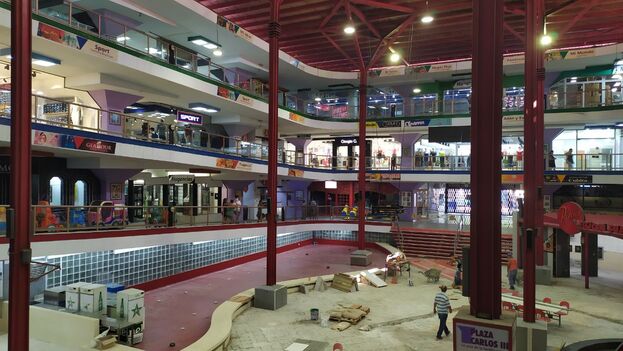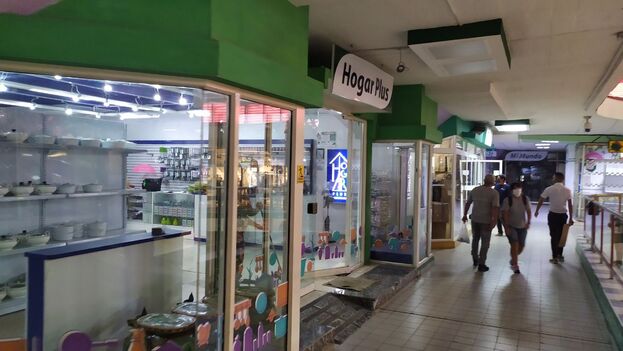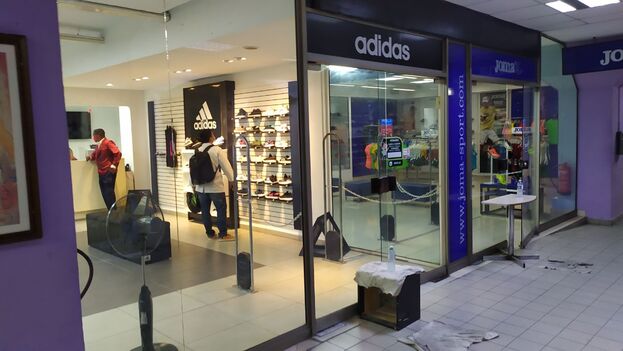
![]() 14ymedio, Juan Diego Rodríguez / Mario J. Pentón, Havana / Miami, 12 October 2020 — Carlos III Plaza Commercial, one of the largest shopping areas in the Cuban capital, reopened this Monday with an important change: from now on you can only buy in foreign currency. The same has happened with most of the large stores in cities in the country’s interior.
14ymedio, Juan Diego Rodríguez / Mario J. Pentón, Havana / Miami, 12 October 2020 — Carlos III Plaza Commercial, one of the largest shopping areas in the Cuban capital, reopened this Monday with an important change: from now on you can only buy in foreign currency. The same has happened with most of the large stores in cities in the country’s interior.
“Ten stores are open at the moment. All of them have a sign in front of them saying that they only accept MLC (freely convertible currency — that is US dollars, euros and other foreign money). There are clothing stores, household supplies, hardware and other items. Other stores are also getting ready to sell in hard currency,” a customer who visited the facilities early in the morning told 14ymedio.
It is one of the largest shopping centers in Havana, also popularly known as “the palace of consumption” and located on an important avenue. It had been closed for months and in recent weeks it was rumored it might reopen as a hard currency store.
It was an open secret that the remodeling the imposing building was undergoing was intended to make it ready for the new genre of commercial establishment, which began at the end of last year, when The Executive opened its first electrical appliances stores and then ones for food and toiletries in foreign currencies in order to alleviate the country’s deep financial liquidity crisis.
For over two decades, Plaza Carlos III has been the commercial heart of Centro Habana, especially in the neighborhoods of Pueblo Nuevo, Cayo Hueso and Los Sitios. Along with the official product lines in their stores, there is an extensive network of informal vendors and private businesses who survive thanks to the flow of customers who shop there every day.
Before being reopened with great fanfare in the 90’s and starting to sell in dollars and later in convertible pesos, the Plaza was but a shadow of what we see today. “They had a dirty agricultural market on the ground floor, a fishmonger on the first floor, and the rest of the building was a state-owned company dedicated to making teaching tools such as dolls to instruct in the structure of human organs,” Luisa, a who lives in nearby Peñalver street tells 14ymedio.

“This neighborhood came back to life when Carlos III was turned into a shopping center in the 90’s. Most of the people here shop or survive thanks to that place,” adds the lady. “Although the government changed the name of the street many years ago to Avenida Salvador Allende, nobody has ever called it that, and when they reopened the Plaza, they named it after the King of Spain.”
Others believe that the new sales method will save Carlos III from the deterioration it had experienced in recent years. “This had become a place for drunks and fights, especially the ground floor area, which had several cafeterias where one couldn’t even go because there were aggressive people drinking beer all the time,” says Orestes, a resident of Calle Salud, who used to take his grandchildren there to play on electronic devices until “the situation became untenable.”
Orestes believes that now, “with a smaller customer base and enjoying a better economic position, it is possible that the environment will improve,” although he acknowledges that he will not be able to shop there for now. “I don’t have access to foreign currency, but this is not the first dollarization of Carlos III. When they opened it in the 90’s, you paid in fulas (slang for dollars) and it seemed to me that I would never be able to shop there, but in the end, I became a regular customer, so I am hoping that now it starts out for a few and then the dollarization might spread.”
The news of the market reopening as a foreign currency store started to spread on the very day that the national television is expected to broadcast a special program announcing new economic measures. But still, many of the residents in the vicinity don’t know of the important change that is taking place inside the Plaza, the only remodeled work in Cuba in the last half century that bears the name of a Spanish king.
In the rest of the country, the dollar is also strengthening. In Cienfuegos, the population has seen how, one by one, the dollar has been conquering the largest stores in the city.
“We are going to be left with no place to shop. La Mimbre, La Pecera, La Nueva Isla, Imago, Mercado Habana, Eureka… everything will sell in dollars, a currency in which I don’t trade in or have the means to obtain,” says Mercedes Bernal, a 51-year-old state worker.
“The other day I went to a store and saw so many products and such a short line that I was amazed. When I asked about the price of an item, I was told it was in dollars and it needed to be paid by a magnetic card. I don’t know how long we are going to be able to hold on,” she adds.

In Cienfuegos, the lines to create bank accounts in dollars are very long, and begin at dawn. The bank only allows 50 customers per day, and delivery dates for the cards are slated for the second week of December.
“Customers do not need to bring dollars to open the account. Only their identity card is enough. The objective of these accounts is for their relatives to eventually send them transfers from abroad so that they can shop in MLC stores,” an employee of Banco Popular de Ahorros told El Nuevo Herald by phone.
For Felicia Carballo from the Pastorita neighborhood and for others who don’t have access to said currency, the situation is becoming increasingly complicated.
“In the Pastorita points-of-sale there is nothing. No soap, no deodorant, nothing. It seems that the TRD stores [where you buy in Cuban convertible pesos – CUC] became the property of Ciego Montero*, because all they have is water,” he commented.
*Translator’s note: Ciego Montero is a Cuban brand of bottled water, part of Nestle’s Waters, owned by the Cuban society Los Portales.
Translated by Norma Whiting
____________
COLLABORATE WITH OUR WORK: The 14ymedio team is committed to practicing serious journalism that reflects Cuba’s reality in all its depth. Thank you for joining us on this long journey. We invite you to continue supporting us by becoming a member of 14ymedio now. Together we can continue transforming journalism in Cuba.
